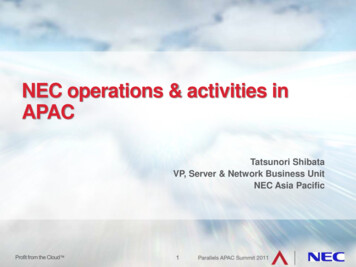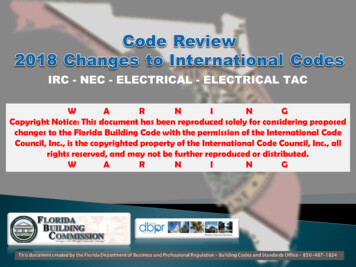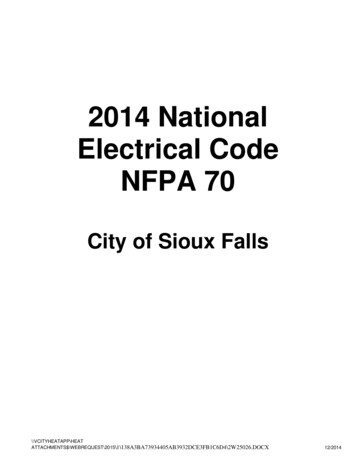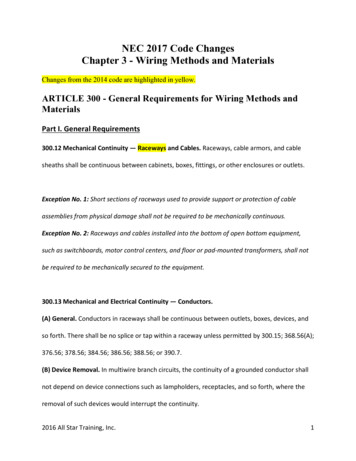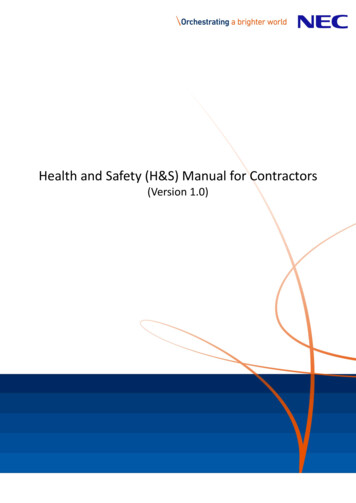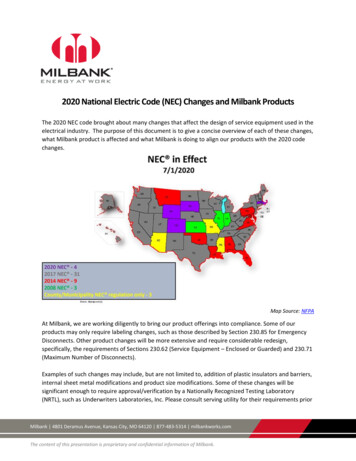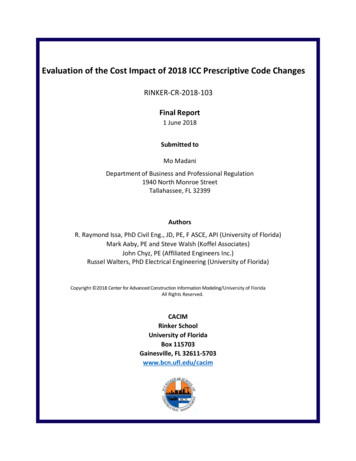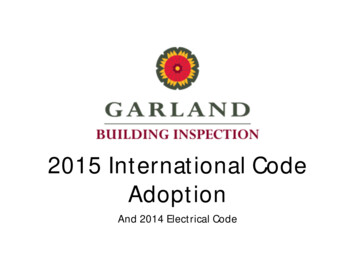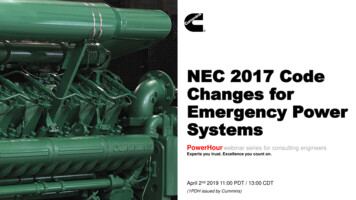
Transcription
NEC 2017 CodeChanges forEmergency PowerSystemsPowerHour webinar series for consulting engineersExperts you trust. Excellence you count on.April 2nd 2019 11:00 PDT / 13:00 CDT(1PDH issued by Cummins)
Welcome!PowerHour is designed to help our engineer partners to Keep up to date on products, technology, and codes and standards development Interact with Cummins experts and gain access to ongoing technical support Participate at your convenience, live or on-demand Earn Professional Development Hours (PDH)Technical tips: Audio is available through teleconference, or your computer (don’tforget to unmute) You are in “listen only” mode throughout the event Use the WebEx Q&A Panel to submit questions, comments, andfeedback throughout the event. We will provide sufficient Q&A time afterpresentation If you lose audio, get disconnected, or experience a poor connection,please disconnect and reconnect Report technical issues using the WebEx Q&A Panel, or emailpowergenchannel@cummins.com2
Meet your panelistsCummins presenter:Cummins facilitator:Rumman KabirTechnical Marketing SpecialistCummins Inc.Tom Bakritzes,Global Sales Training ManagerCummins Inc.Your local Cummins contacts: Western Canada: Ian Lindquist (ian.Lindquist@cummins.com), Western Canada Region South IL, East MO: Jeff Yates (jeffrey.yates@cummins.com), Central Region Eastern Canada: Gianluca Ianiro (gianluca.ianiro@cummins.com), Eastern Canada Region TX, OK, AR, LA, MS, AL, Western TN: Scott Thomas (m.scott.thomas@cummins.com), Gulf Region AZ, ID, NM, NV: Carl Knapp (carl.knapp@cummins.com), Rocky Mountain Region FL, GA, NC, SC, Eastern TN: Robert Kelly (robert.kelly@cummins.com), South Region CO, MT, ND, UT, WY: Chris Scott (chris.scott@cummins.com), Rocky Mountain Region NY, NJ, CT, PA, MD: Charles Attisani (charles.attisani@cummins.com), East Region Northern IL, IA: John Kilinskis (john.a.kilinskis@cummins.com), Central Region CA, HI: Brian E Pumphrey (brian.pumphrey@cummins.com), Pacific Region UP of MI, MN, East ND, WI: Michael Munson (michael.s.munson@cummins.com), Central Region WA, OR, AK: Tom Tomlinson (tom.tomlinson@cummins.com), Pacific Region NE, SD, West MO, KS: Earnest Glaser (earnest.a.glaser@cummins.com), Central Region For other states and territories, email powergenchannel@cummins.com or r3
DisclaimerThe views and opinions expressed in thiscourse shall not be considered the officialposition of any regulatory organization andshall not be considered to be, nor be reliedupon as, a Formal Interpretation.Participants are encouraged to refer to theentire text of all referenced documents. Inaddition, when it doubt, reach out to theAuthority Having Jurisdiction.4
Credit Reproduced with permission from NFPA 70 -2017, National Electrical Code , Copyright 2016,National Fire Protection Association, Quincy, MA 02169. This reprinted material is not thecomplete and official position of the NFPA on the referenced subject, which is represented only bythe standard in its entirety which can be obtained through the NFPA web site at www.nfpa.org.NFPA is neither a sponsor of nor affiliated with Cummins Inc. and has neither endorsed norapproved of the goods and/or services of Cummins Inc. NFPA 70 , the title National Electrical Code and the acronym NEC are registered trademarksof the National Fire Protection Association and thus appropriate credit should be given for thatregistration.5
Course ObjectivesNEC 2017 Code Changes for Emergency Power SystemsThe 2017 National Electric Code (NEC ) introduced provisions that impact emergency power systemdesign. The first provision impacts start signal requirements between the power transfer equipment (suchas a transfer switch) and the emergency generator set controller; the provision requires fail safe operationof the generator set if the start signal wiring is compromised. The second provision address temporarypower source connection requirements during the maintenance or repair of the emergency generator set.This course will take a deep dive into these two requirements including review of exceptions, NEC amendments, and solutions.After completing this course, participants will be able to: Identify key NEC 2017 code changes and related Tentative Interim Amendment (TIA). Describe start signal integrity and temporary generator set connection requirements. Recognize compliant solutions for start signal integrity and temporary generator set connectionprovisions.Reproduced with permission from NFPA 70 -2017, National Electrical Code , Copyright 2016, National Fire Protection Association, Quincy, MA 02169. This reprinted material is not the completeand official position of the NFPA on the referenced subject, which is represented only by the standard in its entirety which can be obtained through the NFPA web site at www.nfpa.org.6
NFPA 70, National Electric Code (NEC)History and Development of the National Electrical Code The National Fire Protection Association has acted as sponsor of the National Electrical Code since1911. The original Code document was developed in 1897 as a result of the united efforts of variousinsurance, electrical, architectural, and allied interests.90.1 Purpose.(A) Practical Safeguarding. The purpose of this Code is the practical safeguarding of persons and propertyfrom hazards arising from the use of electricity. This Code is not intended as a design specification or aninstruction manual for untrained persons.(B) Adequacy. This Code contains provisions that are considered necessary for safety. Compliance therewithand proper maintenance result in an installation that is essentially free from hazard but not necessarilyefficient, convenient, or adequate for good service or future expansion of electrical use.Reproduced with permission from NFPA 70 -2017, National Electrical Code , Copyright 2016, National Fire Protection Association, Quincy, MA 02169. This reprinted material is not the completeand official position of the NFPA on the referenced subject, which is represented only by the standard in its entirety which can be obtained through the NFPA web site at www.nfpa.org.7
Reproduced with permission from NFPA 70 -2017, National Electrical Code , Copyright 2016, National Fire Protection Association, Quincy, MA 02169. This reprinted material is not the completeand official position of the NFPA on the referenced subject, which is represented only by the standard in its entirety which can be obtained through the NFPA web site at www.nfpa.org.8
2017 NEC UpdatesGenerator Control Wiring700.10(D)(3) Generator set must start on lossof integrity from Emergency andFire Pump start circuits.Temporary Source of Power700.3(F) Emergency system shall includea permanent means to connect toa temporary source of powerReproduced with permission from NFPA 70 -2017, National Electrical Code , Copyright 2016, National Fire Protection Association, Quincy, MA 02169. This reprinted material is not the completeand official position of the NFPA on the referenced subject, which is represented only by the standard in its entirety which can be obtained through the NFPA web site at www.nfpa.org.9
Concept CheckNational Electric Code (NEC) requirements are considerednecessary for which of the followinga) Maximizing efficiency of electrical systemsb) Convenience of implementation of electrical systemsc) Safeguarding of persons and property from electrical hazardsd) Ease of future expansion of electrical systems10
Concept CheckNational Electric Code (NEC) requirements are considerednecessary for which of the followinga) Maximizing efficiency of electrical systemsb) Convenience of implementation of electrical systemsc) Safeguarding of persons and property from electrical hazardsd) Ease of future expansion of electrical systems11
Traditional Generator Start Circuit(Normally Closed)Normally closed contact, held open when utility is available. Closes whenutility fails, starting the Generator set.12
Traditional Generator Start Circuit(Normally Closed) Fault: Line BreakGenerator will never start, even during an emergency due to the startcircuit always being open as a result of the line break.13
Traditional Generator Start Circuit(Normally Closed) Fault: Line ShortE Fuel FGenerator set Starts. Without Monitoring and Alarm, facility might run out offuel without an actual emergency being there.14
Generator Control Wiring 700.10(D)(3)Generator Control Wiring. Control conductors installed between the transfer equipment andthe emergency generator shall be kept entirely independent of all other wiring and shall meetthe conditions of 700.10(D)(1). The integrity of the generator control wiring shall becontinuously monitored. Loss of integrity of the remote start circuit(s) shall initiate visual andaudible annunciation of generator malfunction at the generator local and remote annunciator(s)and start the generator(s).Reproduced with permission from NFPA 70 -2017, National Electrical Code , Copyright 2016, National Fire Protection Association, Quincy, MA 02169. This reprinted material is not the completeand official position of the NFPA on the referenced subject, which is represented only by the standard in its entirety which can be obtained through the NFPA web site at www.nfpa.org.15
Generator Control Wiring 700.10(D)(3)Generator Control Wiring. Control conductors installed between the transfer equipment andthe emergency generator shall be kept entirely independent of all other wiring and shall meetthe conditions of 700.10(D)(1). The integrity of the generator control wiring shall becontinuously monitored. Loss of integrity of the remote start circuit(s) shall initiate visual andaudible annunciation of generator malfunction at the generator local and remote annunciator(s)and start the generator(s).Concerns raised: “Integrity” is not defined Does loss of integrity mean a shorted start circuit or a loose connection? Does control wiring also mean Remote start circuit?Reproduced with permission from NFPA 70 -2017, National Electrical Code , Copyright 2016, National Fire Protection Association, Quincy, MA 02169. This reprinted material is not the completeand official position of the NFPA on the referenced subject, which is represented only by the standard in its entirety which can be obtained through the NFPA web site at www.nfpa.org.16
Generator Control Wiring 700.10(D)(3)Tentative Interim Amendment (TIA)Generator Control Wiring. Control conductors installed between the transfer equipment andthe emergency generator shall be kept entirely independent of all other wiring and shall meetthe conditions of 700.10(D)(1). The integrity of the generator control wiring remote start circuitshall be continuously monitored for broken, disconnected, or shorted wires. Loss of integrity ofthe remote start circuit(s) shall initiate visual and audible annunciation of generator malfunctionat the generator local and remote annunciator(s) and start the generator(s).17
Generator Control Wiring 700.10(D)(3)Tentative Interim Amendment (TIA)Generator Control Wiring. Control conductors installed between the transfer equipment andthe emergency generator shall be kept entirely independent of all other wiring and shall meetthe conditions of 700.10(D)(1). The integrity of the generator control wiring remote start circuitshall be continuously monitored for broken, disconnected, or shorted wires. Loss of integrity ofthe remote start circuit(s) shall initiate visual and audible annunciation of generator malfunctionat the generator local and remote annunciator(s) and start the generator(s).TIA Recommendations: Defines “integrity” as “ broken, disconnected, or shorted ” Eliminates control wiring and focuses on remote start circuit Eliminates annunciation requirements Eliminates “continuously monitoring” requirementReproduced with permission from NFPA 70 -2017, National Electrical Code , Copyright 2016, National Fire Protection Association, Quincy, MA 02169. This reprinted material is not the completeand official position of the NFPA on the referenced subject, which is represented only by the standard in its entirety which can be obtained through the NFPA web site at www.nfpa.org.18
Generator Control Wiring 700.10(D)(3)Final LanguageGenerator Control Wiring. Control conductors installed between the transfer equipment andthe emergency generator shall be kept entirely independent of all other wiring and shall meetthe conditions of 700.10(D)(1). The integrity of the generator remote start circuit shall bemonitored for broken, disconnected, or shorted wires. Loss of integrity shall start thegenerator(s).Timeline TIA 17-17 published in the April 2018 Issue of NFPA News TIA issued date: August 14, 2018 TIA effective date: September 3, 2018Reproduced with permission from NFPA 70 -2017, National Electrical Code , Copyright 2016, National Fire Protection Association, Quincy, MA 02169. This reprinted material is not the completeand official position of the NFPA on the referenced subject, which is represented only by the standard in its entirety which can be obtained through the NFPA web site at www.nfpa.org.19
Compliant Start Signal Connection.20
Fault: Line Break21
Fault: Line Short22
Multiple ATS and Single Genset23
Multiple ATS, Multiple Genset24
Concept CheckWhich of the below is a requirement of NEC 2017 startcircuit integrity provision and associated TIAa) Start circuit has to be continuously monitoredb) Loss of integrity shall trigger audible annunciationc) Loss of integrity shall trigger visual annunciationd) Generator shall start if the start circuit has broken/disconnected wiring25
Concept CheckWhich of the below is a requirement of NEC 2017 startcircuit integrity provision and associated TIAa) Start circuit has to be continuously monitoredb) Loss of integrity shall trigger audible annunciationc) Loss of integrity shall trigger visual annunciationd) Generator shall start if the start circuit has broken/disconnected wiring26
Generator Control Wiring 700.10(D)(3)Key Takeaways Must Ensure that generator start circuit is not a single point of failure that willmake power unavailable to emergency loads during a Utility Failure. The requirement does not apply to Legally Required, Optional or COPS ATS(NEC 701, 702 and 708). Generator set and transfer switch manufacturers may provide varying optionsto meet the intent of the code.Spec Note: Specify that Generator and Transfer switch manufacturers provide documentation thatdemonstrate start signal compatibility between the specific models of Generator and ATS per coderequirements of NEC 2017 and TIA 17-17.Reproduced with permission from NFPA 70 -2017, National Electrical Code , Copyright 2016, National Fire Protection Association, Quincy, MA 02169. This reprinted material is not the completeand official position of the NFPA on the referenced subject, which is represented only by the standard in its entirety which can be obtained through the NFPA web site at www.nfpa.org.27
Temporary Source of Power 700.3(F)Temporary Source of Power for Maintenance or Repair of the Alternate Source of Power. If the emergency system relies on a single alternate source of power which willbe disabled for maintenance or repair, the emergency system shall include permanent switching means to connect a portable or temporary alternate source of power, whichshall be available for the duration of the maintenance or repair. The permanent switching means to connect a portable or temporary alternate source of power shall complywith the following:(1)Connection to the portable or temporary alternator source of power shall not require modification to the permanent system wiring.(2)Transfer of power between the normal power source and the emergency power source shall be in accordance with 700.12.(3)The connection point for the portable or temporary alternate source shall be marked with the phase rotation and system bonding requirements.(4)Mechanical or electrical interlocking shall prevent inadvertent interconnection of power sources.(5)The switching means shall include a contact point which shall annunciate at a location remote from the generator or at another facility monitoring system to indicate thatthe permanent emergency source is disconnected from the emergency system.It shall be permissible to utilize manual switching to switch from the permanent source of power to the portable or temporary alternate source of power and to utilize theswitching means for connection of a load bank.Informational Note: There are many possible methods to achieve the requirements of 700.3(F). See figure 700.3(F) for one example.Exception: The permanent switching means to connect a portable or temporary alternate source of power, for the duration of the maintenance or repair, shall not be requiredwhere any of the following conditions exists:(1)All processes that rely on the emergency system source are capable of being disabled during maintenance or repair of the emergency power source.(2)The building or structure is unoccupied and fire suppression systems are fully functional and do not require an alternate power source.(3)Other temporary means can be substituted for the emergency system.(4)A permanent alternate emergency source, such as, but not limited to, a second on-site standby generator or separate electric utility service connection, capable ofsupporting the emergency system, exists.Reproduced with permission from NFPA 70 -2017, National Electrical Code , Copyright 2016, National Fire Protection Association, Quincy, MA 02169. This reprinted material is not the completeand official position of the NFPA on the referenced subject, which is represented only by the standard in its entirety which can be obtained through the NFPA web site at www.nfpa.org.28
Temporary Source of Power 700.3(F)Temporary Source of Power for Maintenance or Repair of the Alternate Source of Power. If the emergency system relies on a single alternate source of power which willbe disabled for maintenance or repair, the emergency system shall include permanent switching means to connect a portable or temporary alternate source of power, whichshall be available for the duration of the maintenance or repair. The permanent switching means to connect a portable or temporary alternate source of power shall complywith the following:(1)Connection to the portable or temporary alternate source of power shall not require modification to the permanent system wiring.(2)Transfer of power between the normal power source and the emergency power source shall be in accordance with 700.12.(3)The connection point for the portable or temporary alternate source shall be marked with the phase rotation and system bonding requirements.(4)Mechanical or electrical interlocking shall prevent inadvertent interconnection of power sources.(5)The switching means shall include a contact point which shall annunciate at a location remote from the generator or at another facility monitoring system to indicate thatthe permanent emergency source is disconnected from the emergency system.It shall be permissible to utilize manual switching to switch from the permanent source of power to the portable or temporary alternate source of power and to utilize theswitching means for connection of a load bank.Informational Note: There are many possible methods to achieve the requirements of 700.3(F). See figure 700.3(F) for one example.Exception: The permanent switching means to connect a portable or temporary alternate source of power, for the duration of the maintenance or repair, shall not be requiredwhere any of the following conditions exists:(1)All processes that rely on the emergency system source are capable of being disabled during maintenance or repair of the emergency power source.(2)The building or structure is unoccupied and fire suppression systems are fully functional and do not require an alternate power source.(3)Other temporary means can be substituted for the emergency system.(4)A permanent alternate emergency source, such as, but not limited to, a second on-site standby generator or separate electric utility service connection, capable ofsupporting the emergency system, exists.Reproduced with permission from NFPA 70 -2017, National Electrical Code , Copyright 2016, National Fire Protection Association, Quincy, MA 02169. This reprinted material is not the completeand official position of the NFPA on the referenced subject, which is represented only by the standard in its entirety which can be obtained through the NFPA web site at www.nfpa.org.29
Temporary Source of Power 700.3(F)Temporary Source of Power for Maintenance or Repair of the Alternate Source of Power.If the emergency system relies on a single alternate source of power which will be disabled formaintenance or repair, the emergency system shall include permanent switching means toconnect a portable or temporary alternate source of power, which shall be available for theduration of the maintenance or repair. The permanent switching means to connect a portable ortemporary alternate source of power shall comply with the following:Reproduced with permission from NFPA 70 -2017, National Electrical Code , Copyright 2016, National Fire Protection Association, Quincy, MA 02169. This reprinted material is not the completeand official position of the NFPA on the referenced subject, which is represented only by the standard in its entirety which can be obtained through the NFPA web site at www.nfpa.org.30
Temporary Source of Power 700.3(F)Temporary Source of Power for Maintenance or Repair of the Alternate Source of Power.If the emergency system relies on a single alternate source of power which will be disabled formaintenance or repair, the emergency system shall include permanent switching means toconnect a portable or temporary alternate source of power, which shall be available for theduration of the maintenance or repair. The permanent switching means to connect a portable ortemporary alternate source of power shall comply with the following:Reproduced with permission from NFPA 70 -2017, National Electrical Code , Copyright 2016, National Fire Protection Association, Quincy, MA 02169. This reprinted material is not the completeand official position of the NFPA on the referenced subject, which is represented only by the standard in its entirety which can be obtained through the NFPA web site at www.nfpa.org.31
Temporary Source of Power 700.3(F)Requirements(1) Connection to the portable or temporary alternate source of power shall not requiremodification to the permanent system wiring.(2) Transfer of power between the normal power source and the emergency power source shallbe in accordance with 700.12.(3) The connection point for the portable or temporary alternate source shall be marked withthe phase rotation and system bonding requirements.(4) Mechanical or electrical interlocking shall prevent inadvertent interconnection of powersources.(5) The switching means shall include a contact point which shall annunciate at a locationremote from the generator or at another facility monitoring system to indicate that thepermanent emergency source is disconnected from the emergency system.Reproduced with permission from NFPA 70 -2017, National Electrical Code , Copyright 2016, National Fire Protection Association, Quincy, MA 02169. This reprinted material is not the completeand official position of the NFPA on the referenced subject, which is represented only by the standard in its entirety which can be obtained through the NFPA web site at www.nfpa.org.32
Temporary Source of Power 700.3(F)Requirements(1) Connection to the portable or temporary alternate source of power shall not requiremodification to the permanent system wiring.(2) Transfer of power between the normal power source and the emergency power source shallbe in accordance with 700.12.(3) The connection point for the portable or temporary alternate source shall be marked withthe phase rotation and system bonding requirements.(4) Mechanical or electrical interlocking shall prevent inadvertent interconnection of powersources.(5) The switching means shall include a contact point which shall annunciate at a locationremote from the generator or at another facility monitoring system to indicate that thepermanent emergency source is disconnected from the emergency system.Reproduced with permission from NFPA 70 -2017, National Electrical Code , Copyright 2016, National Fire Protection Association, Quincy, MA 02169. This reprinted material is not the completeand official position of the NFPA on the referenced subject, which is represented only by the standard in its entirety which can be obtained through the NFPA web site at www.nfpa.org.33
Temporary Source of Power 700.3(F)Requirements(1) Connection to the portable or temporary alternate source of power shall not requiremodification to the permanent system wiring.(2) Transfer of power between the normal power source and the emergency power source shallbe in accordance with 700.12.(3) The connection point for the portable or temporary alternate source shall be marked withthe phase rotation and system bonding requirements.(4) Mechanical or electrical interlocking shall prevent inadvertent interconnection of powersources.(5) The switching means shall include a contact point which shall annunciate at a locationremote from the generator or at another facility monitoring system to indicate that thepermanent emergency source is disconnected from the emergency system.Reproduced with permission from NFPA 70 -2017, National Electrical Code , Copyright 2016, National Fire Protection Association, Quincy, MA 02169. This reprinted material is not the completeand official position of the NFPA on the referenced subject, which is represented only by the standard in its entirety which can be obtained through the NFPA web site at www.nfpa.org.34
Temporary Source of Power 700.3(F)Requirements(1) Connection to the portable or temporary alternate source of power shall not requiremodification to the permanent system wiring.(2) Transfer of power between the normal power source and the emergency power source shallbe in accordance with 700.12.(3) The connection point for the portable or temporary alternate source shall be marked withthe phase rotation and system bonding requirements.(4) Mechanical or electrical interlocking shall prevent inadvertent interconnection of powersources.(5) The switching means shall include a contact point which shall annunciate at a locationremote from the generator or at another facility monitoring system to indicate that thepermanent emergency source is disconnected from the emergency system.Reproduced with permission from NFPA 70 -2017, National Electrical Code , Copyright 2016, National Fire Protection Association, Quincy, MA 02169. This reprinted material is not the completeand official position of the NFPA on the referenced subject, which is represented only by the standard in its entirety which can be obtained through the NFPA web site at www.nfpa.org.35
Temporary Source of Power 700.3(F)Requirements(1) Connection to the portable or temporary alternate source of power shall not requiremodification to the permanent system wiring.(2) Transfer of power between the normal power source and the emergency power source shallbe in accordance with 700.12.(3) The connection point for the portable or temporary alternate source shall be marked withthe phase rotation and system bonding requirements.(4) Mechanical or electrical interlocking shall prevent inadvertent interconnection of powersources.(5) The switching means shall include a contact point which shall annunciate at a locationremote from the generator or at another facility monitoring system to indicate that thepermanent emergency source is disconnected from the emergency system.Reproduced with permission from NFPA 70 -2017, National Electrical Code , Copyright 2016, National Fire Protection Association, Quincy, MA 02169. This reprinted material is not the completeand official position of the NFPA on the referenced subject, which is represented only by the standard in its entirety which can be obtained through the NFPA web site at www.nfpa.org.36
Temporary Source of Power 700.3(F)Requirements(1) Connection to the portable or temporary alternate source of power shall not requiremodification to the permanent system wiring.(2) Transfer of power between the normal power source and the emergency power source shallbe in accordance with 700.12.(3) The connection point for the portable or temporary alternate source shall be marked withthe phase rotation and system bonding requirements.(4) Mechanical or electrical interlocking shall prevent inadvertent interconnection of powersources.(5) The switching means shall include a contact point which shall annunciate at a locationremote from the generator or at another facility monitoring system to indicate that thepermanent emergency source is disconnected from the emergency system.Reproduced with permission from NFPA 70 -2017, National Electrical Code , Copyright 2016, National Fire Protection Association, Quincy, MA 02169. This reprinted material is not the completeand official position of the NFPA on the referenced subject, which is represented only by the standard in its entirety which can be obtained through the NFPA web site at www.nfpa.org.37
Concept CheckWhich of the below is not a requirement of 700.3(F)provision for temporary source of power switching means.a) Connection point has to be marked with Phase rotationb) Shall meet applicable portions of NEC 700.12c) Shall require modification of the permanent system wiringd) Interlock shall be required for preventing inadvertent interconnection ofsourc
NFPA 70, National Electric Code (NEC) History and Development of the National Electrical Code The National Fire Protection Association has acted as sponsor of the National Electrical Code since 1911. The original Code document was developed in 1897 as a result of the united efforts of various
